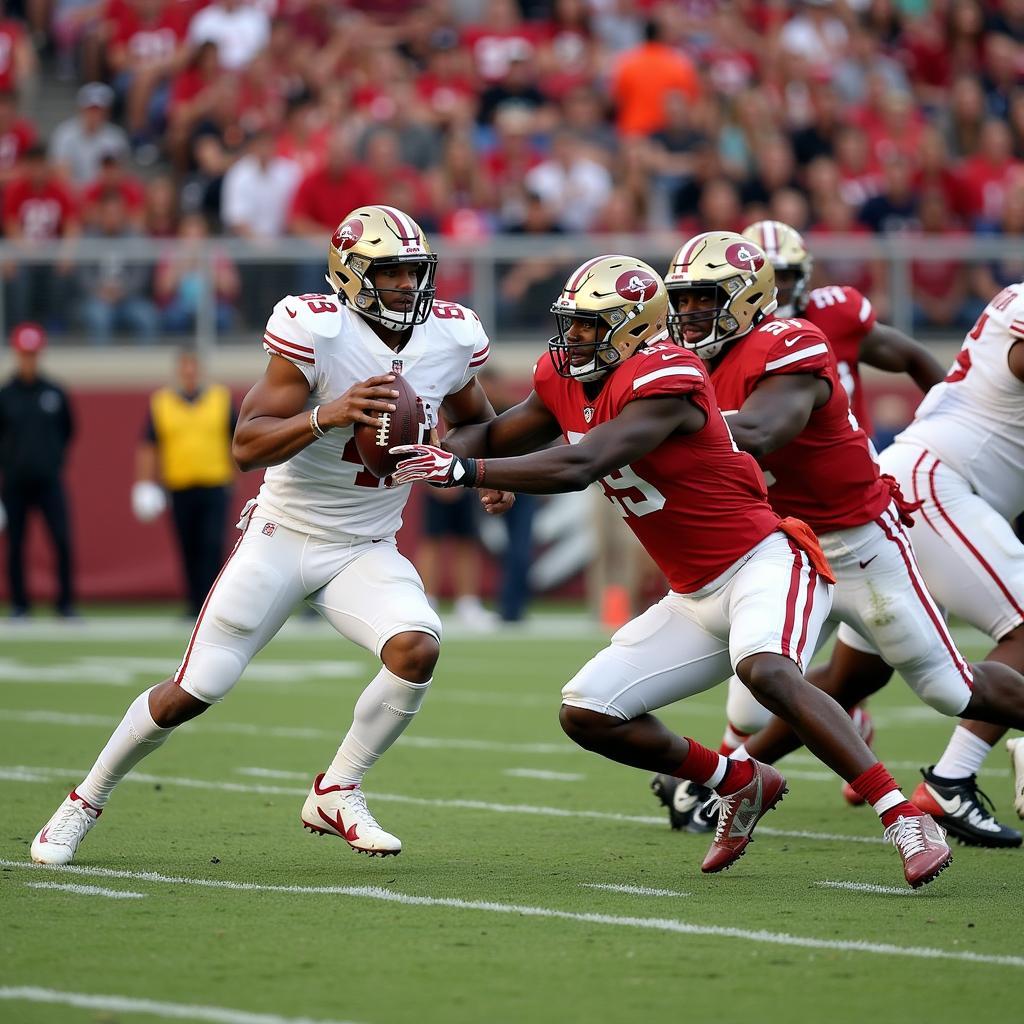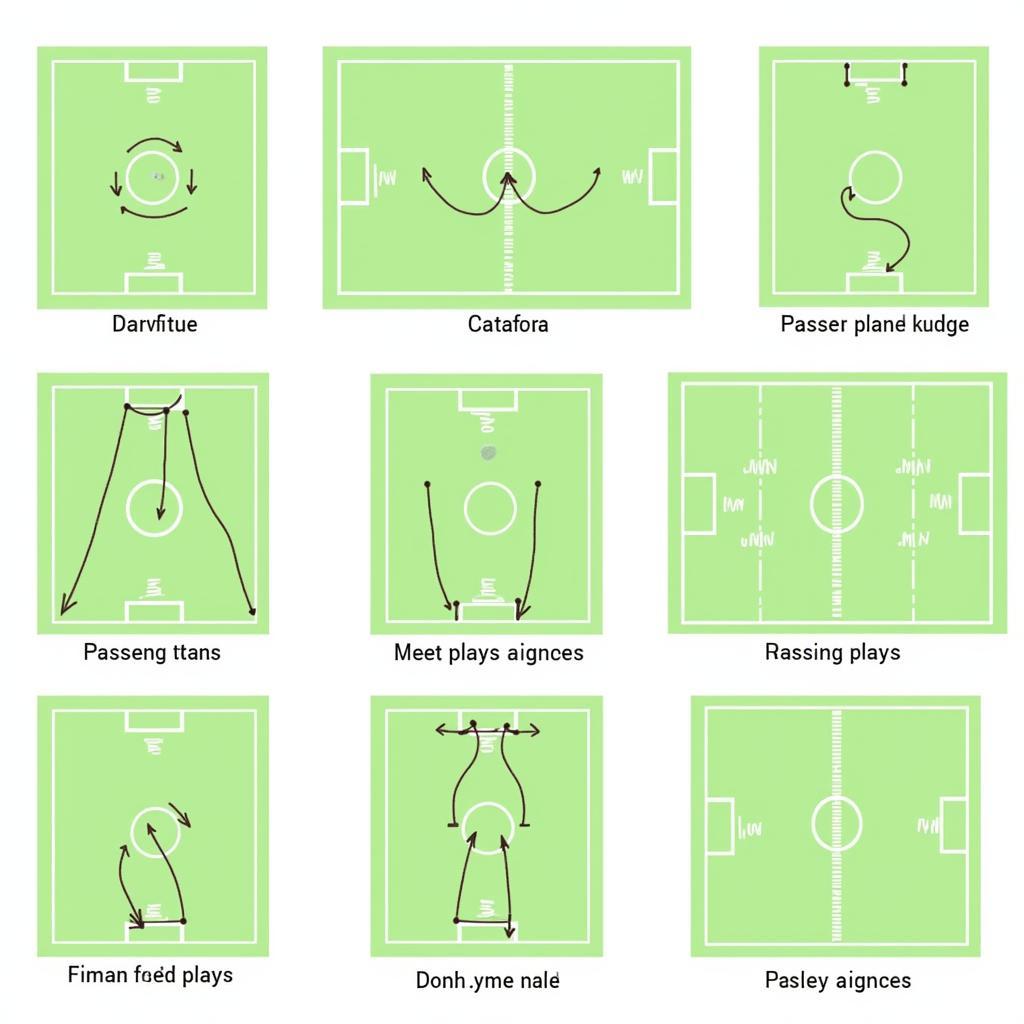The Wishbone Offense Playbook, a relic of a bygone era in football, still holds a certain fascination for football enthusiasts. This in-depth guide will delve into the intricacies of the wishbone formation, exploring its history, key plays, advantages, disadvantages, and how it can still be relevant in modern football. Let’s unpack this unique offensive strategy.
Understanding the Wishbone Formation
The wishbone offense gets its name from the distinctive “Y” shape formed by the three backs positioned behind the quarterback. This formation, popularized in the 1970s and 80s, emphasizes a powerful running game with the option to pass. Its core strength lies in its ability to deceive the defense regarding the direction of the play.
The quarterback, positioned under center, has a triple-option on almost every play: hand off to the fullback diving straight ahead, pitch to a trailing halfback, or keep the ball himself. This creates a multitude of possibilities and forces the defense to account for multiple threats simultaneously.
Key Plays in the Wishbone Offense Playbook
Several plays define the wishbone playbook. The “Dive” is the foundation, a straight-ahead power run by the fullback. The “Pitch” gives the quarterback the option to pitch the ball to a trailing halfback, exploiting the edge of the defense. The “Quarterback Keeper” allows the quarterback to keep the ball and run himself, often utilizing misdirection to gain yardage.
These core plays, combined with variations and counters, create a complex and challenging offensive scheme. The success of the wishbone offense hinges on the execution of these plays and the ability of the offensive line to create running lanes.
 Wishbone Offensive Plays in Action
Wishbone Offensive Plays in Action
Advantages and Disadvantages of the Wishbone Offense
Like any offensive system, the wishbone offense has its strengths and weaknesses. One key advantage is its ability to control the clock by establishing a dominant running game. The multiple options presented to the defense can also lead to confusion and missed tackles. However, the wishbone is susceptible to turnovers if the quarterback makes poor reads or the backs fumble. It also requires disciplined and experienced players, particularly in the offensive line. Furthermore, passing from the wishbone can be challenging, making it predictable in certain situations. You can explore more offensive strategies in our american football defense playbook.
The Wishbone in Modern Football
While less common today, the wishbone still has a place in certain contexts. At lower levels of football, especially high school, the wishbone can be effective due to its emphasis on fundamental blocking and tackling. Some college teams might also incorporate elements of the wishbone into their playbooks to create unique looks and exploit specific defensive weaknesses. Check out more playbook options at college football 25 playbook finder. For those interested in exploring variations on the wishbone formation, you can find more information on wishbone formation plays.
 Modern Variations of the Wishbone Offense
Modern Variations of the Wishbone Offense
Conclusion
The wishbone offense playbook, although not as prevalent as it once was, remains a fascinating and potentially effective offensive strategy. Its emphasis on a strong running game and the triple-option can create significant challenges for defenses. While it may not be suitable for every team, understanding the nuances of the wishbone is crucial for any football aficionado. Explore more about the wishbone playbook in our dedicated guide: wishbone playbook. You can also find creative playbook name ideas at playbook names.
FAQ
- What is the main advantage of the wishbone offense? Its ability to control the clock and establish a dominant running game.
- What is the “triple option” in the wishbone? The quarterback’s choice to hand off, pitch, or keep the ball.
- Is the wishbone still used in modern football? Less common, but still used at some levels, especially high school.
- What is a major weakness of the wishbone? Susceptibility to turnovers and difficulty passing.
- What formation does the wishbone resemble? A “Y” shape formed by the three backs.
- What are the key plays in the wishbone offense? Dive, Pitch, and Quarterback Keeper.
- Why is it called the “wishbone”? Because of the “Y” shaped formation of the backs, resembling a wishbone.
For any assistance, please contact us at Phone Number: 0902476650, Email: [email protected] Or visit us at: 139 Đ. Võ Văn Kiệt, Hoà Long, Bà Rịa, Bà Rịa – Vũng Tàu, Việt Nam. We have a 24/7 customer service team.





